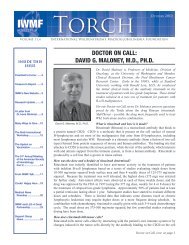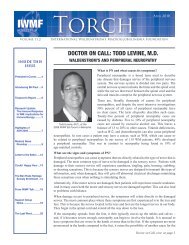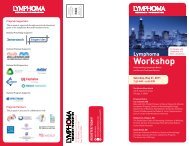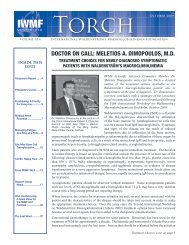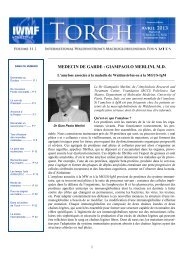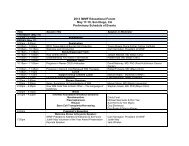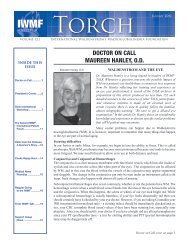Fall 2007 - International Waldenstrom's Macroglobulinemia ...
Fall 2007 - International Waldenstrom's Macroglobulinemia ...
Fall 2007 - International Waldenstrom's Macroglobulinemia ...
Create successful ePaper yourself
Turn your PDF publications into a flip-book with our unique Google optimized e-Paper software.
FROM IWMF-TALK<br />
by Mitch Orfuss<br />
Over the summer months the IWMF-Talk participants aired<br />
their views on many topics concerning treatment options<br />
and coping with the side effects of WM. Some of the livelier<br />
discussions are revisited below.<br />
Is there a “magic” PN drug?–Dianne Perry writes that<br />
Mayo Clinic’s web site recommends B-12 for PN. Guy<br />
Sherwood talked about four candidates for treating PN:<br />
L-glutamine (if taken before chemo); B-6 (with caution not<br />
to exceed 50 mg/day); lysine; and what Guy called the clear<br />
winner for him–morphine after Velcade a few years ago.<br />
Ann Tygart wrote about B-12: not just for PN but perhaps<br />
for memory problems as well, especially when taken in<br />
combo with other B vitamins. However, Liane Cochran-<br />
Stafira raised the possibility that B-6 actually makes PN<br />
worse. And Patti takes the supplements acetyl l-carnitine<br />
and alpha lipoic acid in search of better skin, only to learn<br />
that they are both good for PN.<br />
Shingles–Since WM patients are susceptible to Herpes<br />
zoster, commonly known as shingles, there is frequent<br />
discussion on IWMF Talk about this extremely unpleasant<br />
condition. Rob Selden wrote that though shingles is<br />
contagious only through direct contact with open lesions,<br />
such contact does not result in shingles—it causes chicken<br />
pox and does so only if the receiver never had chicken<br />
pox previously. Minnie Hattori sent several short notes<br />
to shingles newcomers describing the symptoms of this<br />
numbing, tingling, burning, itching, eruptive, blistering and<br />
in all ways relentless illness. Fay Langer emphasized that<br />
while shingles did not cause her pain, it did cause constant<br />
itching severe enough to keep her up at night. June Canter<br />
had another take on how sly shingles can be. When June<br />
came down with shingles during Rituxan treatment there<br />
was no rash at all—so no one immediately recognized<br />
her symptoms as a case of shingles. The result was that it<br />
became too late to make use of an antiviral, leaving June to<br />
three months of pain meds to help her get to sleep. Laure<br />
Van Kerkhove told a story of having shingles along with<br />
spinal encephalitis at age nine, causing pains in her side<br />
that she remembers nightmarishly almost four decades later.<br />
Sybil Whitman recounted having suffered from shingles<br />
four times, occurring both before and after her autologous<br />
SCT last year. After five rounds of chemo Gerri McDonald<br />
attempted to wean herself down to a half dose of the antiviral<br />
Famvir and, sure enough, it was weak enough to allow for<br />
a shingles outbreak. Once the outbreak had passed Gerri<br />
went back to the dose of Famvir which had originally been<br />
prescribed for prevention of shingles. There was also<br />
discussion on how long to keep taking a preventive antiviral<br />
after treatment, and our participants reported a range of<br />
directives from their physicians.<br />
Velcade, Leukeran, Campath–Ellen writes that though<br />
she experienced unpleasant side-effects from Velcade with<br />
cortisone–head and neck ache, sleeplessness, shortness of<br />
breath, and edema in the legs–her blood work did improve,<br />
with hemoglobin and WBC back to normal and a 50%-<br />
reduced monoclonal spike. Ron (The Hermit) Romeis,<br />
for a variety of reasons, elected a 13-month course of daily<br />
Leukeran (chlorambucil) in pill form starting in 2004, with<br />
very satisfactory results—but Ron mused on how difficult<br />
it is to know when sufficient treatment crosses over to too<br />
much. Frank Citrone, Jr., enjoyed a partial remission<br />
from Campath (with hydrocortisone) prior to a SCT. Guy<br />
Sherwood wrote that he had a result similar to Frank’s<br />
except that he had Velcade after Campath at Dana-Farber<br />
before his successful auto transplant. Mike writes that he<br />
was diagnosed at 32 and had Campath as a first treatment<br />
with mixed results: a seven-month partial remission but a<br />
knocked-back immune system.<br />
About Rituxan–After Peter DeNardis referenced an article<br />
about fast-infusion of Rituxan, many replies and comments<br />
were received on IWMF Talk. Corinne wrote that she is<br />
given her Rituxan infusions very slowly. During treatment<br />
she tends to get an itchy head and a puffy, red face, and she<br />
has trouble breathing with a heavy feeling in her chest—plus<br />
“restless leg” from the Benadryl. She actually starts taking<br />
prednisone, Benadryl and Zantac the day before treatment.<br />
Her infusion crew adds Atavan to the IV cocktail along with<br />
the Benadryl, and Corinne sleeps for the entire 12 hours.<br />
Maria writes that she didn’t have side effects after the<br />
treatment—just during. Her blood pressure would drop to<br />
a dangerous level. She could not sit still–it felt like “being<br />
plugged in to a wall socket.” So Maria went to the hospital,<br />
the staff infused her over a 24 hour period, and the problems<br />
evaporated.<br />
From IWMF-Talk, cont on page 14<br />
PAGE 11<br />
How to join the IWMF-TALK<br />
Here are two ways to join:<br />
1. Send a blank e-mail to: iwmf-talk-subscribe-request@lists.psu.edu<br />
Make sure to enter the word subscribe as your subject, and do not sign or put anything in the message area (make sure you<br />
do not have any signature information in there). Also, do not put a “period” after “edu” or it will reject. Once approved<br />
you can post by sending e-mail to iwmf-talk@lists.psu.edu<br />
2. Contact Peter DeNardis at pdenardis@comcast.net and provide your full name



